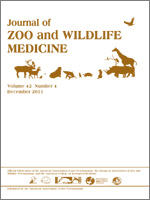Spontaneous endometriosis is an estrogen-dependent, progressive and painful disease that affects a variety of nonhuman primates, including several species of baboons (Papio sp.). This case documents multimodal management of severe endometriosis in a captive female baboon within a zoological institution. An 18-yr-old, intact female Guinea baboon (Papio papio) was found to have an enlarged uterus. Fifteen months post ovariohysterctomy, scarring associated with endometrial tissue resulted in ureteral strictures, bilateral hydronephrosis, and azotemia. Cystoscopic placement of bilateral ureteral stents with fluoroscopy was performed and resulted in short-term clinical improvement. The animal's condition declined and euthanasia was elected 4 mo after ureteral stent placement. Severe endometriosis with secondary inflammation resulting in bilateral hydroureter and hydronephrosis, as well as concurrent cystitis, ureteritis, and pyelonephritis were confirmed at necropsy. Despite possible complications, ureteral stents can be considered a useful therapeutic option in patients with ureteral disease.
How to translate text using browser tools
1 December 2011
Bilateral Hydronephrosis Secondary to Endometriosis Managed by Endoscopic Ureteral Stent Placement in a Captive Guinea Baboon (Papio papio)
Rebecca K. Dallwig,
Jennifer N. Langan,
David A. Hatch,
Karen A. Terio,
Craig Demitros
ACCESS THE FULL ARTICLE
endometriosis
hydronephrosis
nonhuman primate
Papio sp
ureteral stent





